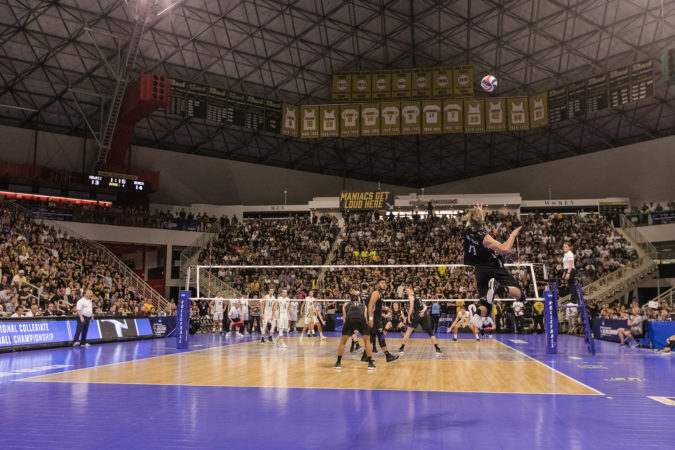
The college men’s volleyball community will have the opportunity to provide feedback to a proposal that would permanently shrink the size of the NCAA Tournament.
The Championships Finance Review Working Group submitted an initial proposal to the Division I Council to reduce the men’s volleyball NCAA Tournament from seven to four teams, according to documents obtained by Off the Block.
The NCAA established this working group prior to the coronavirus pandemic to examine the financial feasibility of all future NCAA Division I and National Collegiate championships. The working group, citing increasing team travel expenses and the lack of revenue from NCAA Tournaments besides basketball, recommended reducing the tournament fields for seven sports, including NCAA Division I-II men’s volleyball.
The NCAA covers the travel and lodging costs associated with teams participating in NCAA Tournaments. The organization spent about $106 million, 10 percent of its total budget, on NCAA Division I and National Collegiate championships in 2019-20, according to the proposal.
The working group’s proposal recommends that sports with more than 50 teams should have a NCAA Tournament field at about 20 percent of teams. Sports with less than 50 teams are recommended to have their tournament size at about 10 percent of teams.
With a seven-team field, 15.9 percent of men’s volleyball teams currently qualify for the NCAA Tournament.
Men’s volleyball in the proposal is listed at fewer than 50 schools resulting in the tournament size decrease.
The proposal, though, does not take into consideration the upcoming growth of NCAA Division I-II men’s volleyball. Men’s volleyball will exceed 50 teams by the 2022 season with the SIAC and six of its schools adding the sport along with Converse College starting a program.
If those new programs were included, men’s volleyball based on the working group’s formula would have at least an eight-team tournament field.
This upcoming growth may be among the feedback that volleyball organizations provide the NCAA and the working group. The working group has requested that conferences, committees and associations provide feedback to its proposal by July 10.
Wade Garard, CEO of the First Point Volleyball Foundation, said in an interview with Off the Block on Friday that his organization along with Kathy DeBour, AVCA executive director, and her organization have already started collaborating to provide feedback to the working group.
“I’m glad the committee reached out to Kathy and the AVCA with a heads up about this report and is offering an opportunity to reply by July 10 in order for us to demonstrate growth,” Garard said. “The AVCA and First Point Volleyball Foundation are fully capable and coordinating to formulate a formal reply.”
The working group did not propose to cut the bracket size of all NCAA Tournaments. Among the recommendations included doubling the size of the women’s beach volleyball NCAA Tournament to 16 teams at a projected cost increase of $450,000.
Along with NCAA Tournament bracket size changes, the working group proposed eliminating all play-in matches.
There is currently one play-in match in the men’s volleyball NCAA Tournament. The play-in match was created in 2018 when the tournament expanded from six to seven teams with the addition of the Big West.
This play-in match ensured that all five conferences — Big West, ConfCarolinas, EIVA, MIVA and MPSF — continued to receive an automatic bid and there were still two at-large bids.
A four-team bracket would result in not every conference being assured a spot in the NCAA Tournament. Instead, the selection committee would have authority to pick only two of the five conference champions for the NCAA Tournament and then round-out the bracket with two at-large bids.
The NCAA historically has preferred to not have automatic bids exceed 50 percent of an NCAA Tournament field.
Men’s volleyball, though, has exceeded that 50 percent provision throughout its history.
The men’s volleyball NCAA Tournament since its inception in 1970 through the 2013 season had featured a four-team field with three conference automatic bids and one at-large bid. The tournament field expanded in 2014 added another at-large bid and automatic bid with the addition of the ConfCarolinas and then expanded again in 2018.
Even if NCAA Tournament size is not altered, the working committee proposal could limit the future growth of the tournament field.
One of the recommendations is that new conferences would not immediately earn an automatic bid to the NCAA Tournament following the standard waiting period. Instead, a new conference would only receive the automatic bid when the NCAA deemed that enough funds were available to expand the tournament bracket.
Among the working group’s other recommendations to reduce NCAA Tournament expenses included reducing the size of each team’s travel party. It also calls for each sport’s NCAA committee to examine the maximum number of players allowed on each team’s active roster for the NCAA Tournament.
The working group’s proposal has yet to be formally submitted to the Division I Council for consideration.
The group will make revisions based on feedback before it is slated in October to submit the proposal to the Division I Council and the various sports committees. The proposal will then be considered by some of the top committees in NCAA before a scheduled vote for final approval in April 2021.
Garard said men’s volleyball coaches or conferences wishing to provide feedback about the working group’s proposal can contact First Point Volleyball Foundation in the upcoming weeks as the organization prepares its response.

One response to “Committee initial proposal calls for men’s volleyball NCAA Tournament contraction”
My biggest problem with this is they seem to count only the Division 1 teams in their 50 teams however the tournament is a combined one including Division 2 teams as well. There are way more than 50 teams combined between the two divisions. If they are going to combine 1&2 then they need to count 1&2 together for their tournament numbers.